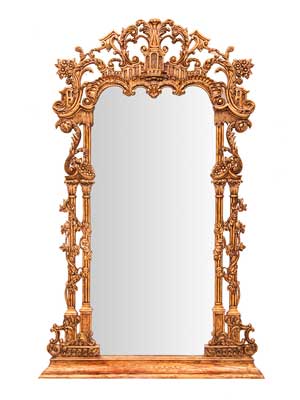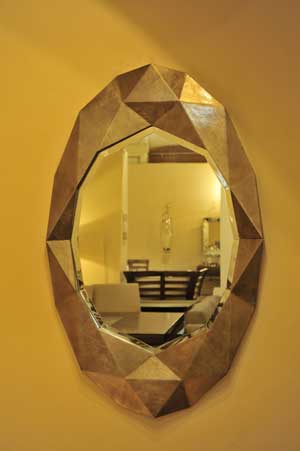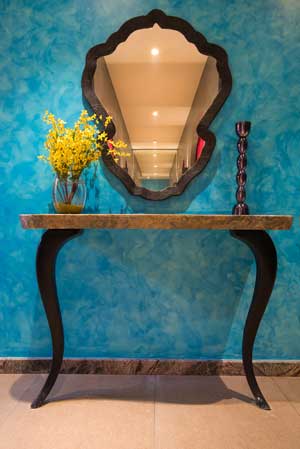How to buy the perfect mirror!
Anemos
Mirrors have been opulent objects of fascination—literally and philosophically! In homes, they not only serve a practical purpose, but also enhance the decor. “Mirrors are no longer restricted to the interiors of a powder room. They have evolved to become an adornment for living rooms, the dining area, walkways or even a porch,” says Shantanu Garg, Interior and Product Designer.
Choosing the right mirror

The Great Eastern Home
“Size, shape, style, colour and placement of the mirror are what you should consider before investing in one,” says RajKumar Jain, Founder, Anemos Lifestyle Pvt Ltd. “The first decision to make when choosing a mirror, is how large it should be. This depends on the size of the wall and on how big an impact you want the mirror to make. A second factor is the shape. While square and rectangular options are common, an unusual shape will catch the eye, even if the mirror is small or lacks a decorative frame. To serve as a strong focal point and to give your wall a touch of sophistication, a more formal and dramatic mirror with an ornate, gilded frame would suit your purpose. The colour of the mirror is just as important as its style. A basic black, white or wood-tone frame can complement virtually any decor. Gilded metals—gold, bronze or silver—add a posh look that fits well with formal or modern decor. If it’s a coloured frame you seek, think about how the frame’s colour plays against your wall shade and aim to create a contrast that draws attention to the mirror,” says Dr Anurag Kanoria, Owner, The Great Eastern Home.
Of course, your choices also depend on the look you want to create. “If you fancy a contemporary look, carved glass or a giant mirror on an accent wall is enough to strike up a conversation. For a classic Indian look, mirrors with intricately carved wooden frames are perfect,” emphasizes Shantanu.
Know your glass!
Italy is known as the home of many types of glass and most of us are familiar with the famous Murano glass, primarily from Venice. But Belgian glass is also popular. “In India, the most frequently used brand Saint-Gobain is of superior quality,” asserts Shilpa Kalanjee Pastala, Managing Partner, Fusion Access.

Fusion Access
When it comes to sourcing glass, reputed sellers assure authentic quality. “Check for three aspects when buying a mirror: glass quality, mirror thickness and mirror silvering. In glass quality, ensure that the glass has no inconsistencies and does not distort reflections. The glass should have a flat surface. Mirrors for the home are available in 1/8, 3/16 and 1/4-inch thickness. It is recommended to have a mirror with 1/4-inch thickness, since it will not distort reflections. Check the thickness of the mirror silvering (ie the coating—usually silver nitrate and other chemical compounds—on one side of the glass),” explains Shilpa.
How much would you need to shell out for a good quality mirror? “Mirror costs can run into lakhs of rupees, but it all comes down to the size and quality you are searching for,” says RajKumar.
Mirroring style

Shantanu Garg
Mirrors give you an open canvas to decorate. “Large-format mirrors open up the room and bring in more light. On the other hand, if you want to be more decorative, a variety of mirrors with different shapes and sizes can create a one-of-a-kind look. They will add intrigue to the entire room, while making the space feel larger than it really is. A smaller, horizontal mirror works in a narrow hallway or staircase. This will widen the space, creating a better flow from one room to the next. A large mirror in a small room creates the illusion of depth. Place a big mirror on the wall above a dining room table to reflect the chandelier. Floor mirrors are ideal in dressing rooms and corners. They can be propped instead of hung for a more stylish effect,” advices Shilpa.
Elaborating on the illuminative power of mirrors, RajKumar says, “A mirror can be an elegant decor asset. Mirrors help brighten and widen even the smallest and darkest of rooms to make them more comfortable and inviting, as they reflect light”. With the plethora of options available in the market, mirrors today clearly offer more than just a mere reflection!
“Size, shape, style, colour and placement of the mirror are what you should consider before investing in one,” says RajKumar Jain, Founder, Anemos Lifestyle Pvt Ltd. “The first decision to make when choosing a mirror, is how large it should be. This depends on the size of the wall and on how big an impact you want the mirror to make. A second factor is the shape. While square and rectangular options are common, an unusual shape will catch the eye, even if the mirror is small or lacks a decorative frame. To serve as a strong focal point and to give your wall a touch of sophistication, a more formal and dramatic mirror with an ornate, gilded frame would suit your purpose. The colour of the mirror is just as important as its style. A basic black, white or wood-tone frame can complement virtually any decor. Gilded metals—gold, bronze or silver—add a posh look that fits well with formal or modern decor. If it’s a coloured frame you seek, think about how the frame’s colour plays against your wall shade and aim to create a contrast that draws attention to the mirror,” says Dr Anurag Kanoria, Owner, The Great Eastern Home.Of course, your choices also depend on the look you want to create. “If you fancy a contemporary look, carved glass or a giant mirror on an accent wall is enough to strike up a conversation. For a classic Indian look, mirrors with intricately carved wooden frames are perfect,” emphasizes Shantanu.Italy is known as the home of many types of glass and most of us are familiar with the famous Murano glass, primarily from Venice. But Belgian glass is also popular. “In India, the most frequently used brand Saint-Gobain is of superior quality,” asserts Shilpa Kalanjee Pastala, Managing Partner, Fusion Access.When it comes to sourcing glass, reputed sellers assure authentic quality. “Check for three aspects when buying a mirror: glass quality, mirror thickness and mirror silvering. In glass quality, ensure that the glass has no inconsistencies and does not distort reflections. The glass should have a flat surface. Mirrors for the home are available in 1/8, 3/16 and 1/4-inch thickness. It is recommended to have a mirror with 1/4-inch thickness, since it will not distort reflections. Check the thickness of the mirror silvering (ie the coating—usually silver nitrate and other chemical compounds—on one side of the glass),” explains Shilpa.How much would you need to shell out for a good quality mirror? “Mirror costs can run into lakhs of rupees, but it all comes down to the size and quality you are searching for,” says RajKumar.Mirrors give you an open canvas to decorate. “Large-format mirrors open up the room and bring in more light. On the other hand, if you want to be more decorative, a variety of mirrors with different shapes and sizes can create a one-of-a-kind look. They will add intrigue to the entire room, while making the space feel larger than it really is. A smaller, horizontal mirror works in a narrow hallway or staircase. This will widen the space, creating a better flow from one room to the next. A large mirror in a small room creates the illusion of depth. Place a big mirror on the wall above a dining room table to reflect the chandelier. Floor mirrors are ideal in dressing rooms and corners. They can be propped instead of hung for a more stylish effect,” advices Shilpa.Elaborating on the illuminative power of mirrors, RajKumar says, “A mirror can be an elegant decor asset. Mirrors help brighten and widen even the smallest and darkest of rooms to make them more comfortable and inviting, as they reflect light”. With the plethora of options available in the market, mirrors today clearly offer more than just a mere reflection!






